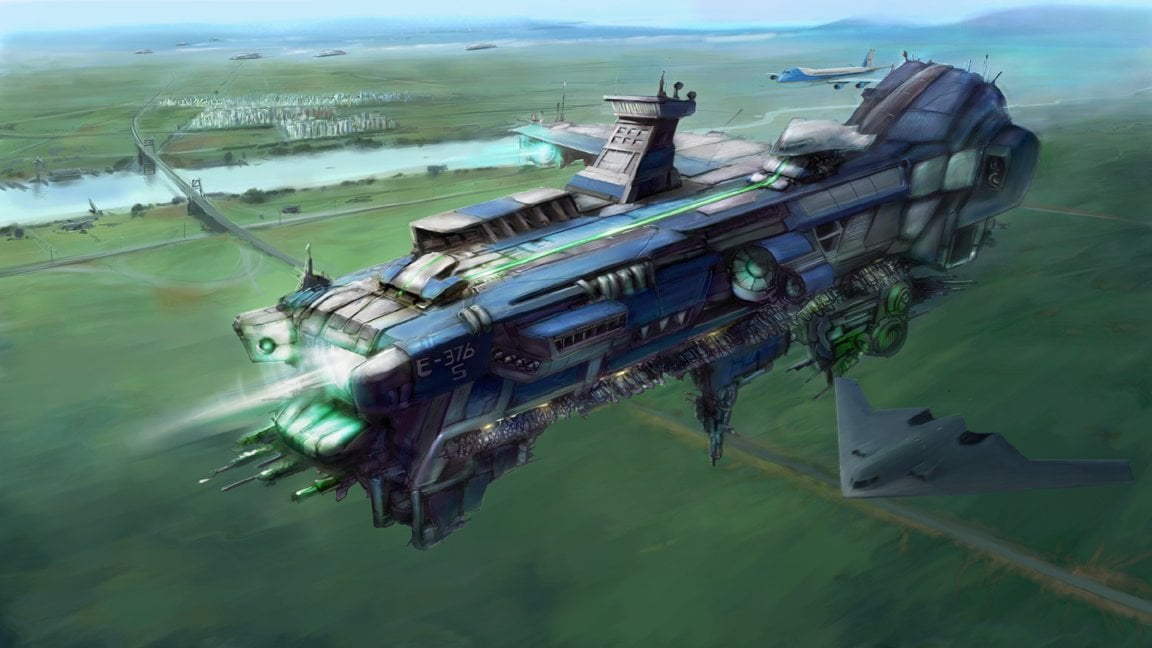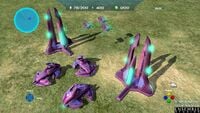Phoenix (Ensemble pitch)
From Halopedia, the Halo wiki
| Phoenix | |
|---|---|
|
Developer(s): |
|
|
Engine: |
|
|
Cancellation date: |
|
|
Genre(s): |
|
Phoenix was the codename of a cancelled video game formerly under development at Ensemble Studios, primarily headed by Graeme Devine. The project is notable as being the original real-time strategy game under development at Ensemble which was eventually, at the behest of Microsoft, turned into Halo Wars.[1]
Phoenix started life as an original Ensemble science fiction strategy game internally codenamed Stratos.[2]
Story and setting[edit]
This article is part of a series on
Halo Wars cut content
- Cut content
- Development
Halo Wars development
Concept art
Storyboards
Title Updates
Halo Wars Alpha
E3 2007 demo
E3 2008 demo
Cancelled sequel
Phoenix
To check out cut content for other Halo games, see here!
Few details are known of the original Phoenix project. The game was set to centre around a The War of the Worlds-style conflict between Earthlings and Martians.[1][3] Only one piece of concept art has been released of this project, showcasing a human "air carrier" carrying refugees away from the fall of Washington D.C - the art showcases a B-2 Spirit stealth bomber, indicating the game's setting may have been intended to be relatively near-future.[4][5] The 2021 TV series Invasion has also been likened to the original Phoenix IP outline, with the alien invasion being viewed from the perspectives of numerous different ordinary people.[6]
In Phoenix, the alien enemies were to have a mechanic involving the ability to build a generator which would allow them to build "fog-of-war killing barriers".[7] The remnants of these structures made their way into an early build of Halo Wars as Covenant structures modelled by 3D artist Duane Santos.[8]
Development[edit]
The origins of Ensemble's wish to create a science fiction strategy game lie in a demo created during the production of the original Age of Empires game in the 1990s. At this time, multiple games were in production: "Tribe" (which later became Age of Empires) and "Stratos",[9] a science fiction game with a futuristic aesthetic seemingly-based on concept art by Ralph McQuarrie for the planet Alderaan in Star Wars.[10] Several Stratos demo images were released on the Age of Empires website,[11] and builds of the final Age of Empires game still retain console commands which reference Stratos.[12] In a 2025 interview on the AoEZone forums, ex-Ensemble designer Sandy Petersen confirmed that Stratos was the origins of what would later become Phoenix, and thus Halo Wars.[2]
It is unclear whether Stratos, and its Star Wars stylings, had any connection to 2001's Star Wars: Galactic Battlegrounds, which was co-developed by Ensemble Studios on the same Genie game engine as Age of Empires.
In early 2004, Ensemble Studios were working on a prototype for a third-person shooter car combat game known as "Wrench". This demo was put together in 7–10 days by Ensemble's team and shown to Bill Gates, who was impressed at the power of the then-in-development Xbox 360's hardware. Ultimately, this game was cancelled by Microsoft, who pressured Ensemble to go back to their core strengths of real-time strategy games, ultimately leading to them starting on the Phoenix prototype. Much of the core code used for developing the graphics systems in "Wrench" was preserved and found its way into Phoenix and the later Age of Empires III.[13][14]
Beginning development later in 2004, Phoenix originally began development as a hack of Ensemble's last project, 2003's Titans expansion for Age of Mythology.[15] The game was originally designed due to Ensemble's wish to bring the "Age [of Empires] experience" to the console[16] - as such the first year of development was spent simply prototyping control schemes and UI designs. Unlike previous console RTS' which simply ported existing PC strategy games, Ensemble wanted to redesign the game experience from the ground-up to work natively with the controller - requiring a large amount of brainstorming over what the core experience of an RTS is and what should be kept. Around 6–7 months into development, then-balance tester Justin Rouse considered the game easier to play on controller than on traditional keyboard and mouse setups; considered a success for the development.[17]
This era also saw much iteration on the game's user interface, and how to design it in a controller-friendly way. Multiple solutions were tried including circle menus like those ultimately used in the final Halo Wars game and even experiments with using sub-menus within the circle menus. This phase of development also saw experimentation with base-building mechanics - something that would be iterated upon for many more years.[17] Tim Deen was one of the programmers involved on the project, and was responsible for implementing many of Devine's ideas.[18]
Overall, the Phoenix project was worked on for around 12–18 months, at which point it was pitched to Microsoft.[19] According to Ensemble manager Tony Goodman, Microsoft at the time was incredibly risk-averse, and ultimately did not feel comfortable with the risk of making a strategy game for a console. As such, they requested that the Halo intellectual property be tied to the game, and the Phoenix IP was effectively killed off. This rework of the game set Ensemble back roughly a year - despite Microsoft's belief that they could simply "paint over what they have with Halo stuff". Goodman went on to state that he never felt "it quite turned out the same".[20] Ex-Ensemble designer Sandy Petersen also noted that the switch from an original IP to the use of Halo hurt Ensemble's team morale and "probably slowed development after that point".[3]
The transition into the Halo IP was similarly met with a cool reception by Bungie, who viewed the game as Microsoft "whoring out the franchise"[20] despite positive public comments.[21] This tense relationship between the two studios meant that Bungie provided little source material for the Ensemble developers, resulting in them having to use Halo film reference material developed for WETA Workshop and screenshots taken inside the public builds of the existing Halo games for reference in manually recreating the Halo assets.[17] Notably, this era also saw the beginning of development for the Halo MMO also by Ensemble, though the game's cancellation in 2007 saw most of its staff redeployed onto the now-underway Halo Wars project.
Legacy[edit]
Although Phoenix was killed off so Halo Wars could live, its legacy remains in several areas of the Halo universe to this day. Primarily, Phoenix remained the codename used for Halo Wars prior to its official announcement even after transition into the Halo IP. In the Halo universe, the Phoenix name was the inspiration for the UNSC Spirit of Fire and the Phoenix-class colony ship it is a part of.[22] In-game, a bird species can be found resembling a Phoenix as another intentional reference[23], and in Halo Wars 2, the Vulture gunship is additionally outfitted with a "Phoenix missile".
The eponymously-named Phoenix engine was developed for the game based itself off the BANG! Engine developed for Age of Mythology, and was later used as a foundation to develop Halo Wars 2, released in 2017.
Sources[edit]
- ^ a b Game Developer, Ensemble Studios: The Last Tour (Retrieved on Sep 21, 2021) [archive]
- ^ a b AoEZone, AMA with an original designer of the Age of Empires franchise - Page 3: "STRATOS was an early code name for the game that ultimately became Halo Wars." - Sandy Petersen (Retrieved on Jun 26, 2025) [archive]
- ^ a b AoEZone, AMA with an original designer of the Age of Empires franchise - Page 2: "We started out doing an entirely different plot. In fact, the alien invaders were martians, not the Flood or Covenant. A large team worked on that project for a year, and then it was decreed that we should switch to having a Halo theme. This hurt the morale of many team members, and probably slowed development after that point.
Please be aware that I was NOT on the Halo Wars game so it didn't affect me at all. When it looked like Halo Wars was lagging, I was brought on to manage and help with playtests of the game (I'd done that for the previous games of course). At one point the idea was to have three separate main civs - Flood, Covenant, Human. But I guess the team felt we had run out of time to have Flood as a playable race. Maybe if we'd done Halo Wars 2." - Sandy Petersen (Retrieved on Jun 26, 2025) [archive] - ^ a b Twitter, Graeme Devine (@zaphodgjd): "I was looking for my old iPhone photos when I found this, I think it’s one of the few pieces of concept art for the original pre-Halo Phoenix project from Ensemble Studios. This is the human air carrier." (Retrieved on Sep 21, 2021) [archive]
- ^ a b Twitter, Graeme Devine (@zaphodgjd): "I can’t remember who the awesome artist is unfortunately, maybe the Internet can help solve that. The air carrier had a forward Yamato style rail gun, this one was the refugee launch from DC as it fell." (Retrieved on Sep 21, 2021) [archive]
- ^ Twitter, Graeme Devine (@zaphodgjd): "This is so the Phoenix IP idea I wrote for Microsoft back before it was Halo. The idea of the story from the perspective of ordinary people is exactly the same. Can’t wait for this show, going to be awesome." (Retrieved on Sep 21, 2021) [archive]
- ^ Twitter, Graeme Devine (@zaphodgjd): "I think they were wall generators? Left over from Phoenix when non-humans could build fog of war killing barriers." (Retrieved on Sep 21, 2021) [archive]
- ^ ArtStation, Halo Wars: Covenant Wraith (Retrieved on Sep 21, 2021) [archive]
- ^ Hacker News, Modding Age of Empires II with a Sprite-Diffuser (Retrieved on Jun 26, 2025) [archive]
- ^ CNN, Building an empire: Exploring the architecture of ‘Star Wars’ (Retrieved on Jun 26, 2025) [archive]
- ^ Age of Empires Heaven, Age of Empires Heaven Gallery - Stratos Demo (Retrieved on Jan 23, 2019) [archive]
- ^ The Cutting Room Floor, Proto:Age of Empires/00.05.01.0204 (Retrieved on Jun 26, 2025) [archive]
- ^ Unseen64, Ensemble Studios (Retrieved on Jan 16, 2021) [archive]
- ^ Twitter, Richard Geldreich (@richgel999): "The Wrench gameplay prototype was a 3rd person outdoor car shooter. We had multiplayer working. The prototype was coming along, but I think Ensemble got pressured by Microsoft to pivot back to RTS game prototypes. This led to the "Phoenix" prototype, which then led to Halo Wars 1" (Retrieved on Dec 23, 2019) [archive]
- ^ Gamasutra, E3: Halo Wars' Rouse: Age Of Mythology Console-Controller Prototype Informed Game's Genesis (Retrieved on Sep 21, 2021) [archive]
- ^ Official Halo Wars Community Site, How to Build a Base in the 26th Century (Retrieved on Jan 17, 2010) [archive]
- ^ a b c Gamasutra, Q&A: How Ensemble Gets Halo Fans To Appreciate Halo Wars (Retrieved on Sep 21, 2021) [archive]
- ^ Twitter, Graeme Devine (@zaphodgjd): "Lot of Phoenix was Tim Deen. I would go to him with crazy ideas, he would say “well, okay.” and somehow make it balance. Great prototype team. I was “when 1,000 humans find an alien walker that should be a problem for the humans”, and you would hear “WALKER!” screamed in testing." (Retrieved on Sep 21, 2021) [archive]
- ^ WorthPlaying, 'Halo Wars' (X360) Developer Interview Part 1 (Retrieved on Sep 21, 2021) [archive]
- ^ a b gamesindustry.biz, Tony Goodman: "The publisher as we know it may become extinct" (Retrieved on Sep 21, 2021) [archive]
- ^ Eurogamer, Bungie "very excited" about Halo Wars (Retrieved on Sep 21, 2021) [archive]
- ^ Twitter, Graeme Devine (@zaphodgjd): "Halo Wars (the Halo RTS) was Codename Phoenix inside Microsoft Game Studios.. I remember many comments about the spelling.. the name of the ship in the game "Spirit of Fire" comes from the internal project name." (Retrieved on Sep 21, 2021) [archive]
- ^ Twitter, Jeff Easterling (@GrimBrotherOne): "Funny how they kinda look like a phoenix, huh? ;-)" (Retrieved on May 29, 2022) [archive]

![One of the few pieces of concept art to have been created for Phoenix.[4][5]](https://halo.wiki.gallery/images/thumb/1/13/HW-Pre-Halo_Wars_Human_Air_Carrier.jpg/200px-HW-Pre-Halo_Wars_Human_Air_Carrier.jpg)



